|
Alaska Department of Health and Social Service Weekly COVID-19 and Influenza Update
January 30 – February 5, 2022
Key Findings
- The incidence of COVID-19 remained very high across most parts of Alaska during the week of January 30–February 5, 2022, though the incidence began to decline in many areas.
- Appreciable levels of influenza transmission began occurring in mid-December but appear to have declined somewhat in the past few weeks.
- Other respiratory viruses are circulating in addition to SARS-CoV-2 and influenza virus.
COVID-19
COVID-19 Case Trends
- High levels of COVID-19 transmission are occurring throughout much of Alaska, but the Omicron wave appears to have peaked, and cases are declining. Hospital admissions of persons with COVID-19 are also declining.
- 10,902 cases were reported in Alaskans the week of January 30–February 5. This is a 30.8% decrease from the number of cases reported the week before.
- The number of reported COVID-19 cases last week was lower in all five of the largest boroughs (Municipality of Anchorage, Matanuska-Susitna, Fairbanks North Star, and Kenai Peninsula Boroughs, and the City and Borough of Juneau) compared to the previous week.
- The intensity of COVID-19 transmission varies between communities outside the largest boroughs. Assessing trajectories is more difficult in less populous areas, but COVID-19 cases appear to be declining in many boroughs and census areas. Regardless, absolute levels of transmission remain high in many areas.
- SARS-CoV-2 genome sequencing has confirmed that the Omicron variant is the dominant SARS-CoV-2 variant in Alaska. Visit Alaska’s SARS-CoV-2 Genomics Dashboard to learn more.
- To learn more about COVID-19 cases, hospitalizations, and deaths due to COVID-19 in Alaska, visit the Cases Dashboard or the monthly report. The cases dashboard includes demographic information on cases and the monthly report includes demographic information on hospitalizations and deaths.
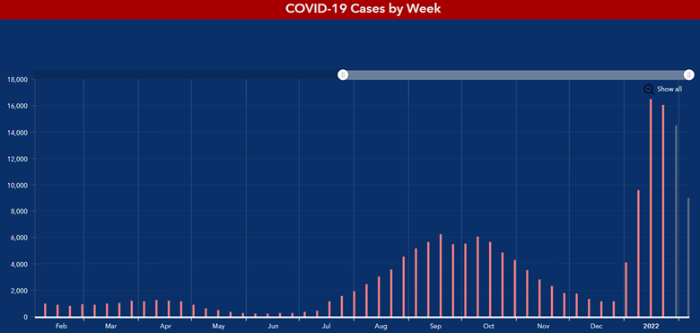
COVID-19 cases among Alaska residents by week of onset date.
Click here to interact with the data
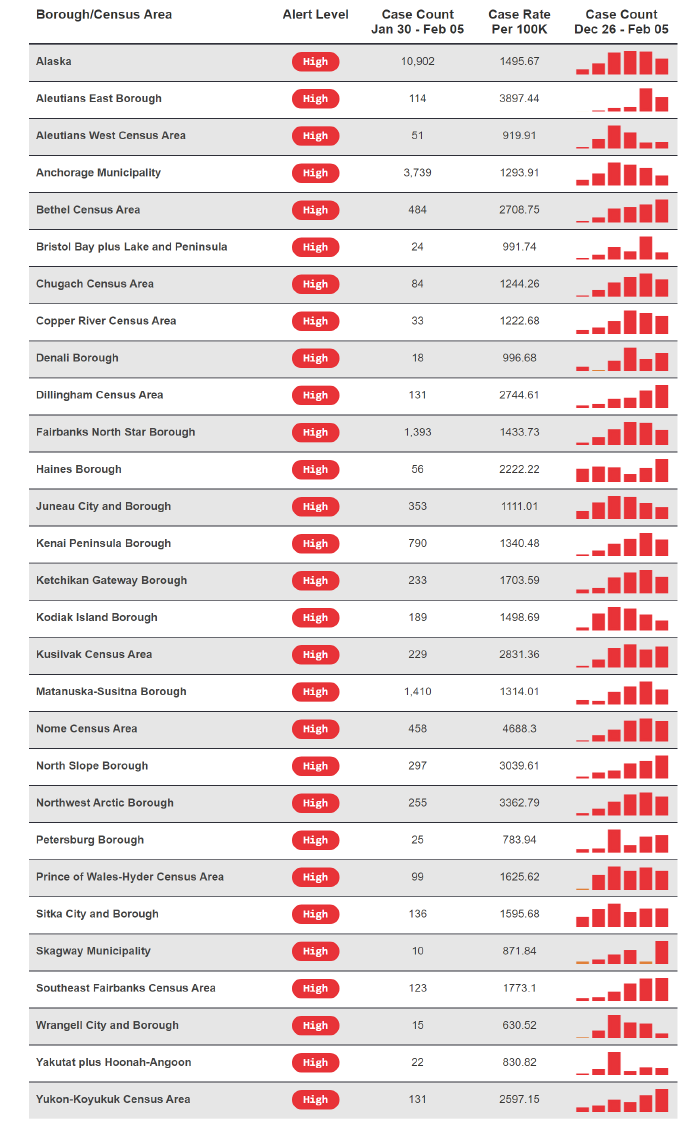
*Rates based on <20 observations are statistically unreliable and should be used with caution.
**Rates based on <6 observations are not reported.
COVID-19 and Hospital Capacity
- Hospital capacity remains limited, with improvement across the state. Staff sick calls, supply chain disruptions, and a high number of ill patients continue to create capacity challenges, with some areas being more affected than others.
- The Crisis Care Committee remains active seeking input from, and providing guidance to, health care providers, including allocating, augmenting, or moving constrained resources during this surge to maximize the health of all Alaskans.
- As of February 7, 2022 there were 127 persons with COVID-19 in Alaska hospitals, accounting for 13% of all hospitalized persons. Visit the Hospital Dashboard for more data.
Total Confirmed COVID-19 Beds

COVID-19 and Vaccination
- 69.2% of Alaska residents aged ≥5 years have received at least one dose of a COVID-19 vaccine. Among those who completed the primary vaccine series, 47.68% of Alaska residents ≥18 years have received their booster. Learn more about COVID-19 vaccination coverage in Alaska on the Vaccine Dashboard.
- Vaccines help protect against infection and against severe disease, especially when a person is up to date on vaccinations. During the 4-week period from January 9, 2022–February 5, 2022, unvaccinated Alaskans were 9.2 times more likely to be hospitalized due to COVID-19 than Alaskans who are up to date on COVID-19 vaccination (i.e., completed the primary series and received a booster dose, if eligible) and 2.6 times more likely to be hospitalized due to COVID-19 than Alaskans who completed the primary vaccination series but are not up to date. (See the monthly report for more data and analysis through December.)
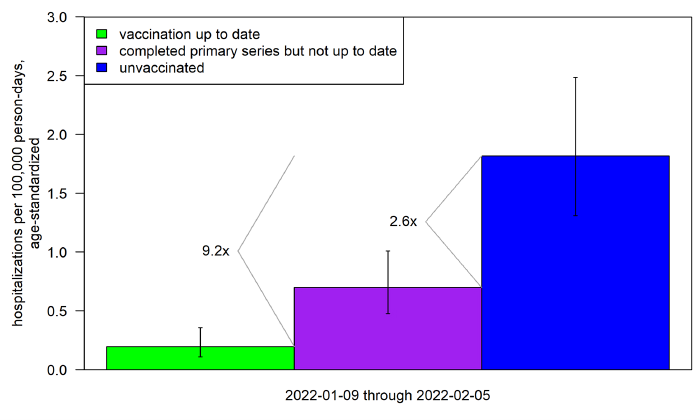
Unvaccinated Alaskans are 9.2 times more likely to be hospitalized due to COVID-19 than Alaskans who are up to date on COVID-19 vaccination and 2.6 times more likely to be hospitalized due to COVID-19 than Alaskans who completed the primary vaccination series but are not up to date. The absolute rates of hospitalization shown here are likely underestimates because of COVID-19 hospitalizations that have not yet been documented. This analysis provides preliminary evidence of how hospitalization incidence rates vary by vaccination status in Alaska when the Omicron variant is dominant.
- Among Alaska residents aged ≥5 years from January 16, 2021–February 5, 2022, 60,915 cases were documented in persons who had completed the primary series and were considered fully vaccinated. Among those vaccine-breakthrough cases, 426 hospitalizations and 146 deaths due to COVID-19 have been recorded. During that time, 93,111 cases have been documented in unvaccinated Alaskans aged ≥5 years, leading to 1,738 hospitalizations and 582 deaths. All data are preliminary and subject to change.
- During the Omicron wave, cases in vaccinated persons have become more frequent, but Alaskans who are up to date on their COVID-19 vaccines (i.e., completed the primary series and received a booster dose, if eligible) still have lower rates of becoming a case than those who are unvaccinated or are not up to date.
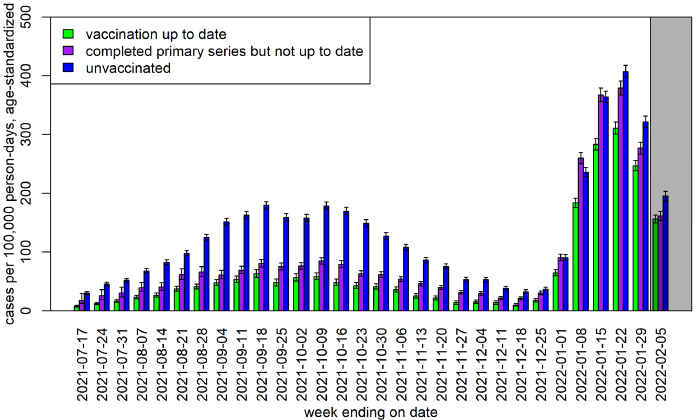
In order to more easily identify changes over time, the definition of “up to date” as of January 8, 2022 was applied to data from all time points. Some COVID-19 cases with specimen collection in the immediate past week (indicated by the grey box) may have not yet been reported or counted.
Influenza (“Flu”)
- Reported influenza cases began increasing in Alaska in mid-December. The number of reported cases the week of January 30–February 5 slightly decreased from the number reported the previous week.
- Right now, most influenza in Alaska is caused by influenza A.
- 23% of Alaskans aged ≥10 years have been vaccinated against seasonal influenza. It is not too late to get vaccinated against influenza.
- Last week, far more cases of influenza were reported from Anchorage than any other region. Learn more in the weekly Alaska Influenza Snapshot.
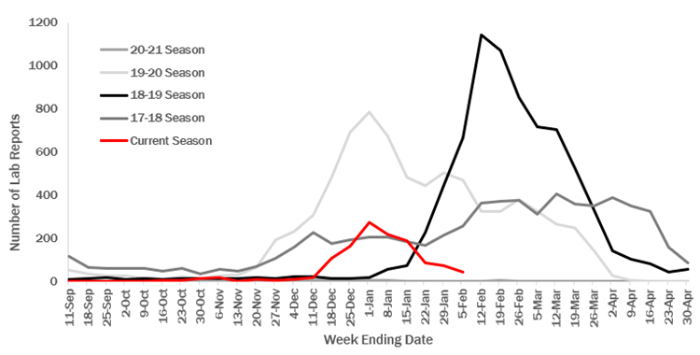
Positive influenza lab reports in Alaska by week of specimen collection for the 2017-2018 influenza season through present. The current season through February 5, 2022 is shown in red.
Emergency Department Visits with COVID-like or Influenza-like Illness
- Syndromic surveillance consists of analyzing data on symptoms and diagnoses among patients visiting emergency departments in Alaska. The main goal is to identify trends. Unlike case-based surveillance, syndromic surveillance does not depend on laboratory testing.
- Influenza-like illness (ILI) is defined as having a fever and at least one other symptom, such cough or sore throat. Patients with a diagnosis of influenza are also included, regardless of symptoms.
- COVID-like illness (CLI) encompasses a broader array of respiratory and other symptoms than influenza-like illness. This category also includes any patient with a diagnosis of COVID-19, regardless of symptoms.
- Patients with a diagnosis of COVID-19 are excluded from the ILI category and, likewise, patients with a diagnosis of influenza are excluded from the CLI category. But a patient without a diagnosis for either could be included in both the CLI and ILI categories. CLI and ILI may be caused by respiratory viruses other than SARS-CoV-2 and influenza virus.
- As the Delta variant wave waned in Alaska in late October and November 2021, the percentage of emergency department patients with CLI declined. However, it has increased over the past few weeks since mid-December, reaching its peak in mid-January. Now, it is at a level lower than that seen at the peak of the Delta wave. The percentage of emergency department patients with CLI the week of January 30–February 5 decreased from the percentage recorded the prior week.
- ILI levels increased in December but have since decreased from the late-December peak.
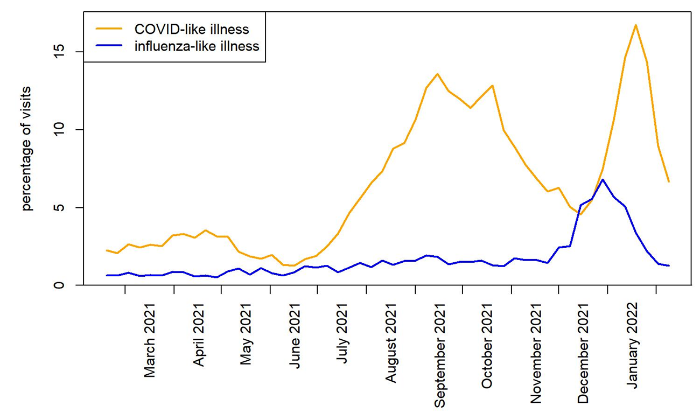
Take action to protect yourself and your family
-
Get vaccinated and stay up to date: COVID-19 vaccines are available for everyone aged 5 and older. Booster shots are available for everyone aged 12 and older if enough time has passed since the initial vaccine series. Getting vaccinated and boosted will help protect you, your family, and your community against COVID-19. Learn more about COVID-19 vaccines. You can visit vaccines.gov or text your zip code to GETVAX (438829) in English, or VACUNA (822862) for Spanish.
-
Masks: As the COVID-19 pandemic evolves, strategies for how and when to use masks also continue to evolve. Not wearing a mask can be more comfortable, increase a person’s ability to interpret facial expressions, and may be beneficial for social development and mental health. Alaskans are encouraged to consider current COVID-19 trends, their own personal risk factors, and other mitigation strategies in-place when deciding where and when to wear a mask, and which kind to wear (e.g., well-fitting N-95/KN-95 masks offer higher levels of protection than other masks). Masks provide both personal protection and protection to others and therefore provide better protection against SARS-CoV-2 transmission when collectively worn. Masks offer the greatest benefit for people who are at increased risk for severe illness (e.g., the elderly, people with underlying medical conditions, and those who are unvaccinated), and in situations where the risk of transmission is high, such as during times when case rates are high, in poorly ventilated indoor spaces, in crowded areas, and in high-risk congregate settings (e.g., nursing homes). Alaska does not have a statewide mask requirement. Communities, private entities, and tribes may require masks if it is within their powers to do so as they balance the needs of the population they serve and their mission.
-
Practice physical distancing: When possible, avoid crowds and keep your distance from others while in public settings – particularly when indoors.
-
Get tested: Seek testing if you have any symptoms or have been exposed to an infected person. If you do test positive, isolate right away and notify your contacts. Ask your contacts to get tested at the appropriate time and, if they are not up to date on COVID vaccination, to quarantine. Learn more about COVID-19 testing.
-
Ask a health care provider about treatment: If you test positive and you’re at increased risk for severe COVID, ask a health care provider about treatment options. Treatments can reduce the risk of hospitalization and they work best when given soon after symptoms start. Learn more about COVID-19 treatments and where you can find COVID-19 treatments. Sotrovimab and PAXLOVID® are in short supply nationally and recommended to be reserved for tier 1 and tier 2 patients. Molnupiravir and remdesivir are more widely available. The monoclonal antibody treatments REGEN-COV® and Bamlanivimab/Etesevimab are no longer being shipped by the federal government because they do not work against the Omicron variant.
Information and Resources
- The State of Alaska COVID-19 vaccines update page
- The State of Alaska COVID-19 information page provides more information about the virus and how individuals and businesses can protect themselves and others from transmission.
- DHSS COVID-19 Communication Toolkit provides PSAs, flyers, and social media graphics.
- Learn more about the importance of physical activity, highlighted by our Play Every Day and our Healthy You 2022 campaigns: Play Every Day.
- Subscribe to the DHSS Insights blog for behind-the-scenes news about Alaska’s COVID-19 response and other efforts to protect the health and well-being of Alaskans.
- DHSS offers free presentations upon request to groups about COVID-19, the vaccines, COVID-19 prevention, or other health topics upon request. Learn more or request a presentation on our Speaker’s Bureau web page.
- For the most up-to-date case information, see the Alaska Coronavirus Response Hub dashboard: data.coronavirus.alaska.gov. All dashboard data are updated Mondays, Wednesdays, and Fridays (except holidays).
- For DHSS media inquiries, please contact clinton.bennett@alaska.gov
ECHO sessions

Session information and recordings of previous ECHO sessions
subscribe to ECHO calendar updates | email: echo@alaskachd.org | website: akecho.org
ECHO sessions create virtual learning communities by connecting Alaska's health experts with specific audiences on specific topics. These sessions are produced and facilitated by UAA’s Center for Human Development Alaska ECHO project in partnership with the State of Alaska, Department of Health & Social Services.
Below is a selection of upcoming ECHO sessions. The full schedule of ECHO sessions and access to COVID-19 ECHO videos and slideshows are available for download anytime on the DHSS ECHO web page.
School Health ECHO
Monday, 3-4 p.m. (Register)
The School Health ECHO is a virtual learning network intended for professionals in the education setting (administrators, school-based nurses, etc.) to interface with a team of medical and education experts in Alaska.
Vaccine ECHO for Providers
Tuesday, 2-3 p.m. (Register)
The Vaccine ECHO for providers provides planning and operation updates to vaccine providers across Alaska, while answering any questions you may have.
Public Science ECHO
Wednesday, noon-1 p.m. (Register)
The Alaska Public Health Science ECHO is a virtual learning network intended for the general public to interface with our Public Health Leadership Team to explore the science of the COVID-19 virus, other public health topics, and current best practices. Or view via concurrent livestream to Facebook: https://www.facebook.com/akechoprograms
Healthcare Specific Situational Awareness ECHO
Thursday, noon-1 p.m. (Register)
The Healthcare Specific Situational ECHO is a virtual learning network intended for healthcare professionals to interface with our Public Health Leadership Team to explore current best practices and the most recent information related to Public Health.
|